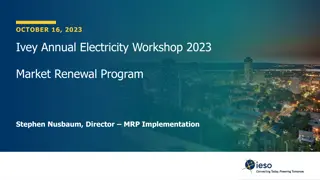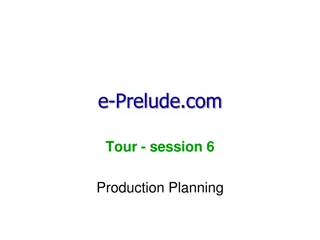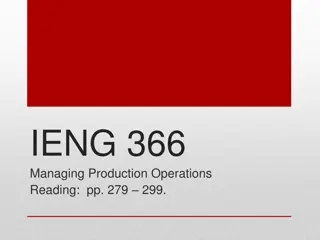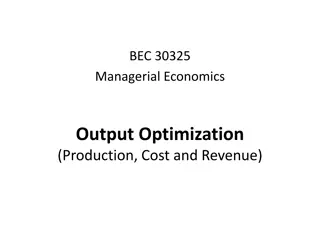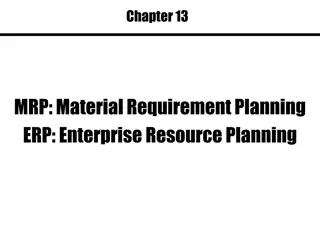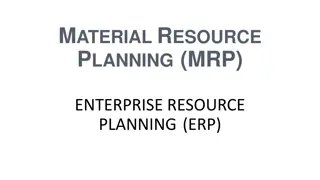
Material Requirement Planning (MRP) at CYCU with Prof. CK Farn
Dive into the world of Material Requirement Planning (MRP) at CYCU with Professor CK Farn. Explore the concept, inputs, and processes involved in MRP, including master schedules, bill of materials, assembly diagrams, and more. Gain insights into how MRP helps in managing production efficiently and meeting demand requirements.
Download Presentation

Please find below an Image/Link to download the presentation.
The content on the website is provided AS IS for your information and personal use only. It may not be sold, licensed, or shared on other websites without obtaining consent from the author. If you encounter any issues during the download, it is possible that the publisher has removed the file from their server.
You are allowed to download the files provided on this website for personal or commercial use, subject to the condition that they are used lawfully. All files are the property of their respective owners.
The content on the website is provided AS IS for your information and personal use only. It may not be sold, licensed, or shared on other websites without obtaining consent from the author.
E N D
Presentation Transcript
11 MRP: Material Requirement Planning (Ch.13) CYCU Prof. CK Farn mailto: ckfarn@gmail.com http://www.mgt.ncu.edu.tw/~ckfarn/cycu 2022.12
MRP: Material requirements planning MRP A computer-based information system that translates master schedule requirements for end items into time-phased requirements for subassemblies, components, and raw materials Designed to answer three questions: What is needed? How much is needed? When is it needed? CYCU Prof CK Farn 2
Overview of MRP CYCU Prof CK Farn 3
MRP Inputs: Master Schedule Master schedule: One of three primary inputs in MRP; states which end items are to be produced, when these are needed, and in what quantities Plan far enough into the future to have reasonable estimates of upcoming demands Should cover a period that is at least equivalent to the cumulative lead time: The sum of the lead times that sequential phases of a process require, from ordering of parts or raw materials to completion of the final assembly CYCU Prof CK Farn 4
Cumulative Lead Time CYCU Prof CK Farn 5
MRP Inputs: Bill of Materials Bill of Materials (BOM) A listing of all of the assemblies, subassemblies, parts, and raw materials needed to produce one unit of a product Product structure tree A visual depiction of the requirements in a bill of materials, where all components are listed by levels CYCU Prof CK Farn 6
Assembly Diagram and Product Structure Tree CYCU Prof CK Farn 7
Low-Level Coding Low-level coding Restructuring the bill of materials so that multiple occurrences of a component all coincide with the lowest level at which the component occurs CYCU Prof CK Farn 8
MRP Inputs: Inventory Records Inventory records Includes information on the status of each item by time period, called time buckets Information about Gross requirements Scheduled receipts Expected amount on hand Other details for each item such as Supplier Lead time Lot size policy Changes due to stock receipts and withdrawals Canceled orders and similar events CYCU Prof CK Farn 9
Assembly Time Chart CYCU Prof CK Farn 10
MRP Outputs: Primary Primary Outputs Planned orders A schedule indicating the amount and timing of future orders Order releases Authorizing the execution of planned orders Changes Revisions of the dates or quantities, or the cancellation of orders CYCU Prof CK Farn 11
MRP Outputs: Secondary Secondary Outputs Performance-control reports Evaluation of system operation, including deviations from plans and cost information for example missed deliveries and stockouts Planning reports Data useful for assessing future material requirements for example purchase commitments Exception reports Data on any major discrepancies encountered for example late and overdue orders, excessive scrap rates, requirements for nonexistent parts CYCU Prof CK Farn 12
MRP Processing MRP processing takes the end item requirements specified by the master schedule and explodes them into time- phased requirements for assemblies, parts, and raw materials offset by lead times CYCU Prof CK Farn 13
MRP Record Week Number 1 2 3 4 5 6 Gross Requirements Scheduled Receipts Projected on hand Net requirements Planned-order receipt Planned-order release Gross requirements Total expected demand Scheduled receipts Open orders scheduled to arrive Projected Available Expected inventory on hand at the beginning of each time period CYCU Prof CK Farn 14
MRP Record (cont.) Week Number Gross Requirements Scheduled Receipts Projected on hand Net requirements Planned-order receipt Planned-order release 1 2 3 4 5 6 Net requirements Actual amount needed in each time period Planned-order receipts Quantity expected to received at the beginning of the period offset by lead time Planned-order releases Planned amount to order in each time period CYCU Prof CK Farn 15
MRP: Development The MRP is based on the product structure tree diagram Requirements are determined level by level, beginning with the end item and working down the tree The timing and quantity of each parent becomes the basis for determining the timing and quantity of the children items directly below it The children items then become the parent items for the next level, and so on CYCU Prof CK Farn 16
Example MRP CYCU Prof CK Farn 17
Example MRP (cont.) CYCU Prof CK Farn 18
Using the MRP Pegging The process of identifying the parent items that have generated a given set of material requirements for an item CYCU Prof CK Farn 19
Updating the System An MRP is not a static document As time passes Some orders get completed Other orders are nearing completion New orders will have been entered Existing orders will have been altered Quantity changes Delays Missed deliveries CYCU Prof CK Farn 20
Updating the System (cont.) Two basic systems Regenerative system Approach that updates MRP records periodically Essentially a batch system that compiles all changes that occur within the time interval and periodically updates the system A revised production plan is developed in the same way the original plan was developed Net-change system Approach that updates MRP records continuously The production plan is modified to reflect changes as they occur Only the changes are exploded through the system CYCU Prof CK Farn 21
MRP Benefits Enables managers to easily Determine the quantities of each component for a given order size Know when to release orders for each component Be alerted when items need attention Additional benefits Low levels of in-process inventories The ability to track material requirements The ability to evaluate capacity requirements A means of allocating production time The ability to easily determine inventory usage via backflushing Exploding an end item s BOM to determine the quantities of the components that were used to make the item CYCU Prof CK Farn 22
MRP Requirements To implement an effective MRP system requires: A computer and the necessary software to handle computations and maintain records Accurate and up-to-date Master schedules Bills of materials Inventory records Integrity of data files CYCU Prof CK Farn 23
MRP Difficulties Consequence of inaccurate data Missing parts Ordering incorrect numbers of items Inability to stay on schedule Other problems Assumptions of constant lead times Products being produced differently from the BOM Failure to alter a BOM when customizing a product Inaccurate forecasts CYCU Prof CK Farn 24
MRP II Manufacturing resources planning (MRP II) Expanded approach to production resource planning, involving other areas of the firm in the planning process and enabling capacity requirements planning Most MRP II systems have the capability of performing simulations to answer a variety of what if questions so they can gain a better appreciation of available options and their consequences CYCU Prof CK Farn 25
MRP II: Overview CYCU Prof CK Farn 26
Closed Loop MRP When MRP II systems began to include feedback loops, they were referred to as Closed Loop MRP Closed Loop MRP Systems evaluate a proposed material plan relative to available capacity If a proposed plan is not feasible, it must be revised This evaluation is referred to as capacity requirements planning CYCU Prof CK Farn 27
Capacity Requirements Planning Capacity requirements planning (CRP) The process of determining short-range capacity requirements. Inputs to capacity requirement planning Planned-order releases for the MRP Current shop loading Routing information Job time Key outputs Load reports for each work center CYCU Prof CK Farn 28
Load Reports Load reports Department or work center reports that compare known and expected future capacity requirements with projected capacity availability CYCU Prof CK Farn 29
Enterprise Resource Planning Enterprise resource planning (ERP) ERP was the next step in an evolution that began with MRP and evolved into MRPII ERP, like MRP II, typically has an MRP core ERP provides a system to capture and make data available in real time to decision makers and other users throughout an organization ERP systems are composed of a collection of integrated modules CYCU Prof CK Farn 30
Overview of ERP Software Modules Module Brief Description Accounting/Finance Acentral component of most ERP systems. It provides a range of financial reports, including general ledger, accounts payable, accounts receivable, payroll, income statements, and balance sheets Marketing Supports lead generation, target marketing, direct mail, and sales Human Resources Maintains a complete data base of employee information such as date of hire, salary, contact information, performance evaluations, and other pertinent information Purchasing Facilitates vendor selection, price negotiation, making purchasing decisions, and bill payment Production Planning Integrates information on forecasts, orders, production capacity, on-hand inventory quantities, bills of material, work in process, schedules, and production lead times Inventory Management Identifies inventory requirements, inventory availability, replenishment rules, and inventory tracking Distribution Contains information on third-party shippers, shipping and delivery schedules, delivery tracking Sales Information on orders, invoices, order tracking, and shipping Supply Chain Management Facilitates supplier and customer management, supply chain visibility, and event management CYCU Prof CK Farn 31
ERP Project Organization The big bang Companies cast off all of their legacy systems at once and implement a single ERP system across the entire company The most ambitious and difficult implementation approach Franchising strategy Independent ERP systems are installed in each business unit of the enterprise while linking common processes across the enterprise Suits large or diverse companies that do not share many common processes across business units Slam dunk ERP dictates the process design where the focus is on a few key processes More appropriate for smaller companies expecting to grow into ERP CYCU Prof CK Farn 32
ERP Considerations How can ERP improve a company s business performance? How long will an ERP implementation project take? How will ERP affect current business processes? What is the ERP total cost of ownership? What are the hidden costs of ERP ownership? CYCU Prof CK Farn 33

